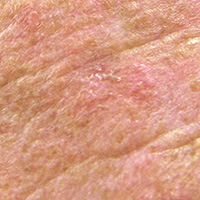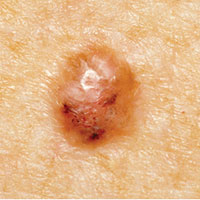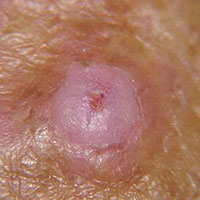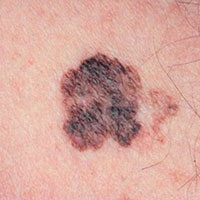Skin Cancer
Skin cancer continues to be the most common type cancer in the United States. Some of the more common ones include basal cell carcinoma (most frequent), squamous cell carcinoma and malignant melanoma. Melanoma is potentially the deadliest skin cancer and needs to be distinguished from benign pigmented moles or nevi. Each skin cancer has different levels of aggressiveness and subtypes that make their necessary treatment unique.
4 Common Types of Skin Cancer

Actinic Keratoses (AK) (pre-cancerous)
These dry, scaly patches or spots are precancerous growths that usually show up after 40 years of age. People who get AKs usually have fair skin and they tend to develop on areas of chronic sun exposure such as on the face, head, neck, hands and forearms. Because AKs can progress to a specific type of skin cancer (squamous cell carcinoma) treatment and close follow up is essential.

Basal cell carcinoma (BCC)
This is the most common type of skin cancer. BCCs frequently develop in people who have fair skin, yet they can occur in people with darker skin. BCC looks like a flesh-colored, pearl-like bump or a pinkish patch of skin. BCCs develop after years of frequent sun exposure or indoor tanning. BCC are common on the head, neck, and arms, yet can form anywhere on the body, including the chest, abdomen, and legs. This type of skin cancer grows slowly and rarely spreads to other parts of the body. But, the growth can be very wide and destructive to adjacent skin tissue and bone causing significant damage and disfigurement. Early diagnosis and treatment is essential.

Squamous cell carcinoma (SCC)
SCC is the second most common type of skin cancer. People who have light or reddish type skin are more likely to develop SCC, yet they can develop in darker-skinned people. SCC often looks like a red firm bump, scaly patch, or a sore that heals and then re-opens. SCC tend to form on skin that gets frequent sun exposure, such as the rim of the ear, face, scalp, neck, arms, chest, and back. SCC can grow deep and wide into the skin and cause significant destruction. Early diagnosis and treatment can prevent this and minimize potential spread to other areas of the body.

Melanoma
Melanoma is the deadliest form of skin cancer. They frequently develop in an existing mole or may suddenly appear as a new dark spot on the skin. Melanoma may develop in areas without chronic or typical sun exposure and can develop in other areas of the body. Early diagnosis and treatment are crucial. Melanoma is almost always curable when found in the early stages but growth and spread make treatment more difficult. They account for most of the deaths from skin cancer.
Knowing the ABCDE warning signs of melanoma can help you decide when to seek medical advice and potentially find an early melanoma.
The ABCDE of Melanoma

Examine both halves of the lesion to determine symmetry. One half appearing different than the other side may be concerning.

Look at the border around the lesion. Determine if there is an irregular, scalloped or poorly defined outline.

Visualize and compare the colors throughout the lesion. Multiple shades and scattered variations may be worrisome.

Gauge and measure the diameter of the lesion. Melanomas are usually greater than 6mm (the size of a pencil eraser) when diagnosed, but they can be smaller in size.

Consider how the lesion looked previously or how it compares to other areas. A mole that changes in size, shape or color or looks different than others should be medically examined.
When should I seek medical assistance?
A good rule to follow is; seek medical advice for any new skin lesion that looks abnormal, one that has changed in appearance or size, seems to come and go or develops symptoms such as itchiness, flakiness, discoloration or bleeding.
If you have a personal history or a family history of skin cancers, especially melanoma or dysplastic/abnormal nevi or moles or have had significant sunburn or sun damage in the past, you should seek medical advice. Remember, many skin lesions do not in fact turn out to be skin cancers and can simply be left alone, but it is critically important to determine which ones are safe to leave and which need to be removed.
Types of Treatment
The treatment for skin cancer depends on the type of skin cancer, its stage, location, and other individual factors. Treatment options may include:
- Surgery:
- Excision: Surgically removing the cancerous tissue along with a margin of healthy surrounding tissue.
- Mohs surgery: A specialized surgical technique that involves removing thin layers of skin one at a time and examining them under a microscope until no cancer cells are detected.
- Radiation Therapy:
- External beam radiation: Using targeted radiation to kill cancer cells.
- Brachytherapy: Placing a radiation source directly on or inside the skin.
- Topical Treatments:
- For superficial skin cancers or precancerous lesions:
- Topical chemotherapy: Applying medications directly to the skin.
- Immunotherapy creams: Stimulating the immune system to target cancer cells.
- For superficial skin cancers or precancerous lesions:
- Cryotherapy:
- Freezing cancer cells using liquid nitrogen.
- Electrosurgery (Curettage and Electrodesiccation):
- Scraping away cancer cells followed by electrocautery to destroy any remaining cells.
- Photodynamic Therapy (PDT):
- Using a photosensitizing agent and light to destroy cancer cells.
- Systemic Treatments:
- For advanced or metastatic skin cancer, especially melanoma:
- Targeted therapies: Drugs that target specific molecules involved in cancer growth.
- Immunotherapy: Boosting the body's immune system to fight cancer.
- For advanced or metastatic skin cancer, especially melanoma:
- Chemotherapy:
- Systemic chemotherapy may be considered in certain cases, but it is less common for most skin cancers.
The choice of treatment depends on factors such as the type and stage of skin cancer, its location, and the overall health of the individual. Early detection and treatment are crucial for better outcomes, especially for melanoma, which can be more aggressive.
It's important for individuals with skin cancer to work closely with their healthcare professional to recommend an appropriate treatment plan tailored to the individual's needs. Additionally, regular follow-up appointments and skin checks are essential for monitoring and detecting any potential recurrences and improve outcomes.
If you notice any changes in your skin, including moles or other lesions, or if you have concerns about skin cancer, it's important to consult with a healthcare professional.
Schedule Your Appointment Now

